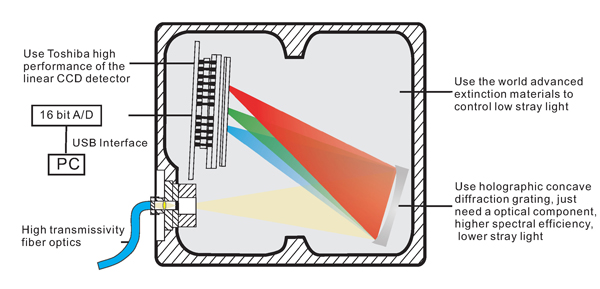LMS-9000C High Precision CCD Spectroradiometer is according to LM-79 clause 9.1. It is designed for any visible optical spectrum distribution analysis, mimicking various light sources in the visible region by feedback control of the radiant power emitted by individual LEDs. This LED optical spectrum analyzer is used as a transfer standard for photometric, colorimetric and radiometric applications.
LMS-9000C can do quick test with high accuracy. It used in scientific lab. It works with 적분 구 and standard lamp as a system: LPCE-2 High Precision Spectroradiometer Integrating Sphere System.
표준:
CIE 177 "백색 LED 광원의 컬러 렌더링"
CIE84 "광속 측정"
CIE-13.3 "광원의 컬러 렌더링 속성을 측정하고 지정하는 방법"
LM-79-19 "솔리드 스테이트 조명 제품의 광학 및 전기 측정"
IESNA LM-63-2 "광도 데이터 및 관련 정보의 전자적 전송을 위한 IESNA 표준 파일 형식"
IES LM-80-08 “Measuring Lumen Maintenance of LED Light Sources”
ANSI-C78.377 "전기 램프용 고체 조명 제품의 색도 사양"
(EU) 2019/2015 "위원회 위임 규정"
측정:
- 비색: 색도 좌표, CCT, 색비, 피크 파장, 반대역폭, 주 파장, 색 순도, CRI, CQS, TM-30(Rf, Rg), 스펙트럼 테스트
• Photometric: Luminous Flux, Luminous Efficiency, Radiant Power, WPE, EQE, EEI, Energy Efficiency Class, Pupil Flux, Pupil Flux Efficiency, Pupil Factor, Cirtopic Flux, Plant Growth Lamp PAR and PPF
• Electrical: Voltage, Current, Power, Power Factor, Displacement Factor, Harmonic
• LED optical maintenance test: Flux VS time, CCT VS time, CRI VS time, Power VS time, Power Factor VS time, Current VS time and Flux Efficiency VS time
사양:
• Spectral Wavelength Accuracy: ±0.3nm, Wavelength Reproducibility: ±0.1nm
- 샘플 스캔 단계: ±0.1nm
• Accuracy of Chromaticity Coordinate (Δx, Δy): ±0.002 (under Standard A Lamp)
• Correlated Color Temperature CCT: 1,500K~100,000K, CCT Accuracy: ±0.3%
• Color Rendering Index Range: 0~100.0, Accuracy: ±(0.3%rd±0.3)
• Luminous Flux Range: 0.01-200,000lm; Photometric linear Accuracy: ±0.5%
• Stray light: <0.015%(600nm) and <0.03%(435nm)
• Integration Time: 0.1~10,000ms
• It can measure the temperatures inside and outside of integrating sphere
• Total flux testing method: spectrum, photometric and spectrum with photometric revision
| LISUN 모델 | LMS-9000C | LMS-9000CUV-VIS | LMS-9000CVIS-NIR | LMS-9000CUV |
| Wavelength | 350-800nm | 200-800nm | 350-1050nm | 200-400nm |
The LMS-9000C (which is updated on LMS-9000B) uses the band pass-filter wheel correcting technique, spectrometer & broadband-radiometer & photometer combined technique, and modified NIST stray light correction technology. The LMS-9000C spectroradiometer can realize ultra low stray light and super photometry linearity in overall dynamic range.

LISUN LPCE-2(LMS-9000C) High Precision Spectroradiometer Integrating Sphere System – After-sales Frequently Asked Questions (FAQ).
LISUN LPCE-2(LMS-9000C) High Precision Spectroradiometer Integrating Sphere System were in the market for more than 10 years, LISUN engineers service team already summary the most of the After Sales Questions and Answers in the above link. Please read it carefuly, you can solve the most of the problems by yourself if you have some questions while using the instruments. LISUN will be continue to update this pages and more FAQ can be found in this topic link.








